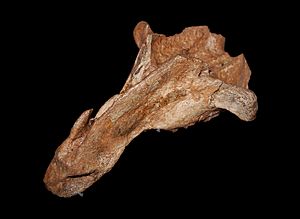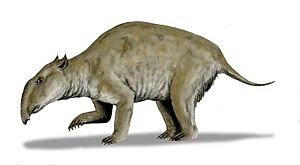Palorchestes facts for kids
Palorchestes (say: Pal-or-KESS-teez) was an amazing animal that lived a long, long time ago in Australia. Its name means "ancient leaper" or "ancient dancer." It was a type of marsupial, like kangaroos and koalas, but it was much bigger! Palorchestes was a plant-eater and belonged to a special family called Palorchestidae. These creatures lived from the Miocene to the Pleistocene periods.
Quick facts for kids Palorchestes |
|
|---|---|
 |
|
| Scientific classification |
|
| Kingdom: | Animalia |
| Phylum: | Chordata |
| Class: | Mammalia |
| Infraclass: | Marsupialia |
| Order: | Diprotodontia |
| Family: | †Palorchestidae |
| Genus: | †Palorchestes Owen, 1873 |
| Type species | |
| Palorchestes azael Owen, 1873 |
|
Contents
What's in a Name?
The name Palorchestes was first given in 1873 by a scientist named Richard Owen. He found a piece of a jawbone and thought it belonged to a giant, ancient kangaroo. That's why he called it "ancient leaper."
Later, in 1945, another scientist, Harold Fletcher, translated the name as "the ancient dancer." But as more bones were found, scientists realized that Palorchestes was not a kangaroo at all! It was actually related to diprotodonts, which were huge, rhino-like marsupials. In 1958, Jack T. Woods from the Queensland Museum helped correct this mistake.
There was an older animal called Propalorchestes that might have been an ancestor to Palorchestes. They had similar teeth, but Propalorchestes had a shorter snout.
Scientists have found bones from about five or six different kinds of Palorchestes:
- P. anulus
- P. azael
- P. painei
- P. parvus
- P. pickeringi
- P. selestiae
What Did Palorchestes Look Like?
The most well-known species, Palorchestes azael, was about the size of a horse. It could be around 2.5 meters (8 feet) long and weigh more than 1,000 kilograms (2,200 pounds)!
Palorchestes had four strong legs. Its front legs had big claws, a bit like a koala's. It probably used these claws to pull down branches and strip bark from trees to eat.
Its lower jaw suggests it had a long, flexible tongue, similar to a giraffe's. For a long time, scientists thought Palorchestes had a short trunk, like a tapir. This earned it the nickname "marsupial tapir." However, newer studies suggest it might have had strong, grasping lips instead of a trunk.
The teeth of Palorchestes show that it ate plants like shrubs and roots.
Where Did Palorchestes Live?
Palorchestes fossils have been found in many places in eastern Australia. More than 30 sites have yielded bones, mostly from the later species, P. azael. Some remains of P. azael were found at the famous Naracoorte Caves National Park fossil site in Australia.
Scientists study these fossil sites to understand how Palorchestes and other ancient animals lived and changed over time.
How We Imagine Palorchestes
For a long time, people thought Palorchestes was a giant kangaroo. The Australian Museum even made a model of it in the early 1900s, showing it as a kangaroo that could stand 3 meters (10 feet) tall!
But when scientists realized it was a diprotodont, not a kangaroo, the museum ordered the model to be destroyed. Some say it's buried somewhere in Sydney's Centennial Park.
Over the years, artists and scientists have made different drawings and models of Palorchestes. Some showed it with a tapir-like trunk. Later, new ideas suggested it might have looked more like a giant ground sloth.
Some ancient rock art in Australia, which shows animals like the extinct thylacine, might even include pictures of Palorchestes. These drawings seem to match the idea of Palorchestes looking like a ground sloth.
Images for kids
See also
 In Spanish: Palorchestes para niños
In Spanish: Palorchestes para niños



